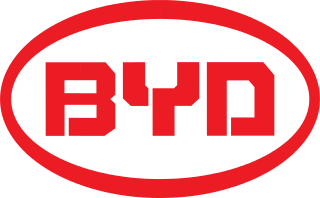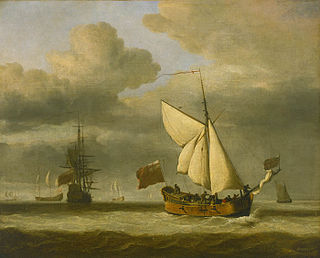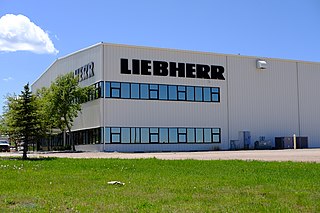
Scania AB is a major Swedish manufacturer headquartered in Södertälje, focusing on commercial vehicles—specifically heavy lorries, trucks and buses. It also manufactures diesel engines for heavy vehicles as well as marine and general industrial applications.

A winch is a mechanical device that is used to pull in or let out or otherwise adjust the tension of a rope or wire rope.

A crane is a type of machine, generally equipped with a hoist rope, wire ropes or chains, and sheaves, that can be used both to lift and lower materials and to move them horizontally. It is mainly used for lifting heavy things and transporting them to other places. The device uses one or more simple machines to create mechanical advantage and thus move loads beyond the normal capability of a human. Cranes are commonly employed in transportation for the loading and unloading of freight, in construction for the movement of materials, and in manufacturing for the assembling of heavy equipment.

A dragline excavator is a piece of heavy equipment used in civil engineering and surface mining.

BYD Auto Co., Ltd. is the automotive subsidiary of the publicly-listed Chinese multinational manufacturer BYD Company, headquartered in Xi'an, Shaanxi Province, China. It was founded in January 2003, following BYD Company's acquisition of Qinchuan Automobile Company in 2002. The company produces passenger cars, buses, trucks, electric bicycles, forklifts and rechargeable batteries. The current model range of automobiles includes battery electric vehicles (BEVs) and plug-in hybrid electric vehicles (PHEVs), and the company also produced petrol engine vehicles up until March 2022.

The Saipem 7000 is the world's third largest semi-submersible crane vessel, after the SSCV Sleipnir and the SSCV Thialf. It is owned by the oil and gas industry contractor Saipem S.p.A.

Wire rope is several strands of metal wire twisted into a helix forming a composite rope, in a pattern known as laid rope. Larger diameter wire rope consists of multiple strands of such laid rope in a pattern known as cable laid.

An overhead crane, commonly called a bridge crane, is a type of crane found in industrial environments. An overhead crane consists of two parallel rails seated on longitudinal I-beams attached to opposite steel columns by means of brackets. The traveling bridge spans the gap. A hoist, the lifting component of a crane, travels along the bridge. If the bridge is rigidly supported on two or more legs running on two fixed rails at ground level, the crane is called a gantry crane or a goliath crane.

A hoist is a device used for lifting or lowering a load by means of a drum or lift-wheel around which rope or chain wraps. It may be manually operated, electrically or pneumatically driven and may use chain, fiber or wire rope as its lifting medium. The most familiar form is an elevator, the car of which is raised and lowered by a hoist mechanism. Most hoists couple to their loads using a lifting hook. Today, there are a few governing bodies for the North American overhead hoist industry which include the Hoist Manufactures Institute, ASME, and the Occupational Safety and Health Administration. HMI is a product counsel of the Material Handling Industry of America consisting of hoist manufacturers promoting safe use of their products.
Konecranes Oyj is a Finnish company, headquartered in Hyvinkää, which specialises in the manufacture and service of cranes and lifting equipment. Konecranes products are made for industries handling heavy loads meaning ports, intermodal terminals, shipyards and bulk material terminals.
Newport Docks is the collective name for a group of docks in the city of Newport, south-east Wales.

A collier is a bulk cargo ship designed or used to carry coal. Early evidence of coal being transported by sea includes use of coal in London in 1306. In the fourteenth and fifteenth centuries, coal was shipped from the River Tyne to London and other destinations. Other ports also exported coal – for instance the Old Quay in Whitehaven harbour was built in 1634 for the loading of coal. London became highly reliant on the delivery of coal by sea – Samuel Pepys expressed concern in the winter of 1666–67 that war with the Dutch would prevent a fleet of 200 colliers getting through. In 1795, 4,395 cargoes of coal were delivered to London. By 1824, this number had risen to about 7,000; by 1839, it was over 9,000. The trade continued to the end of the twentieth century, with the last cargo of coal leaving the Port of Tyne in February, 2021.
Events in the year 1924 in Norway.
Sverre Munthe-Kaas Munck was a Norwegian businessperson.

Liebherr is a German-Swiss multinational equipment manufacturer based in Bulle, Switzerland, with its main production facilities and origins in Germany.

The automotive industry in Sweden is mainly associated with passenger car manufacturers Volvo Cars and Saab Automobile but Sweden is also home of two of the largest truck manufacturers in the world: AB Volvo and Scania AB. The automotive industry is heavily dependent on export as some 85 percent of the passenger cars and 95 percent of the heavy vehicles are sold outside of Sweden. The automotive industry and its sub-contractors is a major part of Swedish industry. In 2011 around 110,000 people were employed and the export income of 150 billion SEK accounted for 12 per cent of Sweden's export income. During 2009 128,738 passenger cars and 27,698 heavy vehicles were built in Sweden. Koenigsegg is also a famous swedish company which makes some of the fastest cars in the world, but also some of the most expensive. They make cars like:Koenigsegg Jesko, Gemera, 1:One, Agera, Regera etc.
Oskar Andreas Munch was a Norwegian businessperson. He started his career in the company of his father, Sverre Munck, and eventually became chairman of Elektrisk Bureau and Asea Brown Boveri.
American Crane Corporation is an American manufacturer of construction cranes based in Wilmington, North Carolina. It manufacturers lattice boom crawler cranes with capacities ranging from 50 to 275 tons. The American Crane Corporation was founded in 1882 as the Franklin Manufacturing Company, and in 1892 the name changed to American Hoist & Derrick. The company manufacturers terrain cranes, crawler cranes and tower cranes. In 1998 American Crane Corporation was acquired by Terex for $27 million. The purchase of American Crane Corporation brought Terex a manufacturer of lattice boom cranes.

A hydraulic jigger is a hydraulically-powered mechanical winch.
A patented track crane is a crane with a bottom flange of hardened steel and a raised tread to improve rolling.












